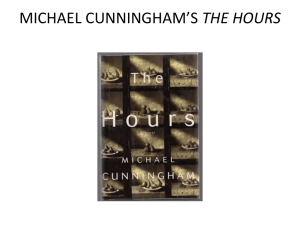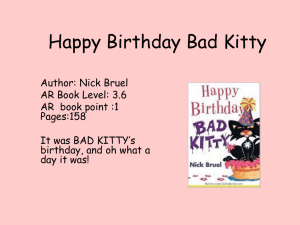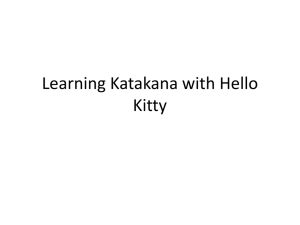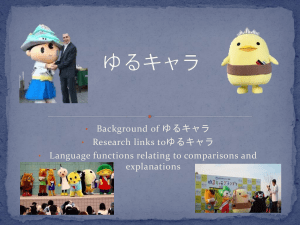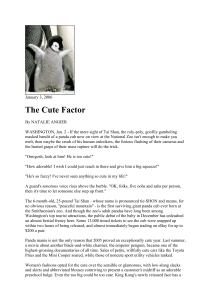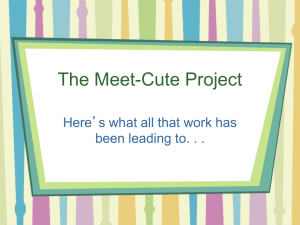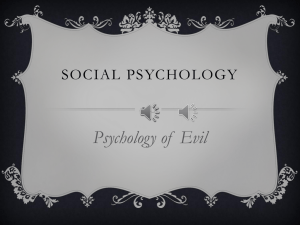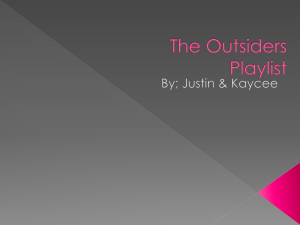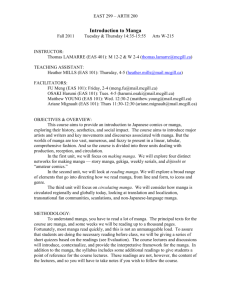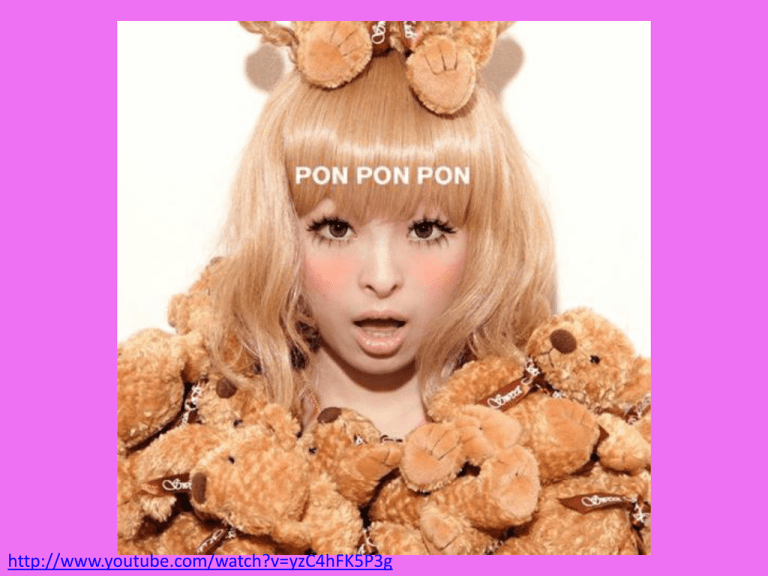
http://www.youtube.com/watch?v=yzC4hFK5P3g
Kawaii
emerged in the 1970s
when young girls started to draw cute
hearts and stars in a more ideographic
form, and was written laterally (rather
than in traditional vertical kanji). This
was banned in schools eventually but got
picked up in the 80s. It may mean
cuteness, adorable, loveable, innocent,
pretty, lovely – its kanji stem is
literally ‘can love’.
http://www.ultrakawaii.com/
http://www.allthingskawaii.net/links/
http://www.youtube.com/watch?v=W6wGXFkQbTs
Scientists studying the evolution of visual signaling have apparently identified
‘cute cues’ -- ever expanding range of features and behaviours associated with
cute. Cute is:
Rounded not sculptured
Soft over refined
Clumsy over quick
Affectionate and a lap
Signifiers of childhood and Youth, high voice
vulnerability, helplessness
harmlessness and need
colours
Cute features include, bright, forward facing eyes, big round face, big round
ears, floppy limbs, side to side teeter totter gait.
“Cute things cannot do anything for themselves -- ”
Hello Kitty as an interesting hybrid, global fantasy.
Name: Kitty White
Birthday: November 1, 1974
Age: 36 (as of January 2011)
Blood type: A
Place of birth: London, England
“When Hello Kitty was created, many girls in Japan had read Alice in Wonderland and adored
Britain. Also, there were other characters [created by my company Sanrio] who were supposed
to have been born and raised in the U.S., so Kitty was born in London as a way of
differentiating her.” Yuko Tamaguchi, Designer 2008 for Hello Kitty
Readmore: http://www.time.com/time/magazine/article/0,9171,1834451,00.html#ixzz1Fq7CyT2W
Favorite food: Apple Pie (baked by Grandma)
Favorite word: "Friendship"
Description:
A bright and kind-hearted girl, good at baking cookies and loves Mama's apple pie.
Very close to her twin sister Mimmy.
Height: 5 Apples Tall
(The above is straight from Wikipedia and the site actually has many good references)
Hello Kitty is more than just a character, it has become major
Corporate logo. The major figure of Sanrio corporation, Hello
Kitty’s popularity is inexplicable, adorning all objects from hairclips
to sex toys, from telephones to machine guns, credit cards and
vehicles. First appeared in 1974, Hello Kitty is the brain child of
Yuko Shimizu. The character has literally become the ambassador
for Japan of Tourism, a UNICEF logo, as well as a character
ambassador for Breast Cancer. Still a global phenomenom, it is
losing popularity in Japan and apparently in 2002, was third (in
sales) behind characters like Ampanman and Pokeman.
http://www.sanrio.com/
Creator: Mori Chack
(http://www.chax.cc/index.html)
2006.
Height: a little over 6 feet tall
Weight: around 2000 Pomegranates
Created as alternative to Hello Kitty.
Gloomy Bear’s craze is a bit
controversial as not everyone has
taken to this bear. Difficult to find
products in the West at the moment.
Natsume Sōseki, 1867 - 1916
Wagahai wa neko de aru, 1905 (?)
A satire seen through a cat’s eyes, commentary
on the ‘westernization’ of Meiji Japan
The uses of enchantment: My Neighbour Totoro (1988).
Set in a nostalgic 1958, the movie tells of a university
professor and his daughters moving to the country while
their mother recuperates in the hospital. The girls lives are
transformed when they meet the creatures of the forests
who help them cope with the displacement and their
mother’s sickness. Totoro and the Cat Bus are central figures.
Post-WW2 Japan and Global Cuteness:
Making Nuclear Power Adorable
“Atoms for Peace” Speech delivered by Dwight D Eisenhower to the UN
General Assembly in New York, December 8, 1953 (as part of Operation Candor,
Offers comfort to a world post Hiroshima and Nagasaki)
I feel impelled to speak today in a language that in a sense is new – one which I,
who have spent so much of my life in the military profession, would have preferred
never to use.
That new language is the language of atomic warfare.
Against the dark background of the atomic bomb, The United States does
not wish merely to present strength, but also the desire and hope for peace.
The United States pledges before you--and therefore before the world--its determination
to help solve the fearful atomic dilemma--to devote its entire heart and mind to find the
way by which the miraculous inventiveness of man shall not be dedicated to his death,
but consecrated to his life.
See transcript of speech http://www.world-nuclear-university.org/about.aspx?id=8674&terms=atoms%20for%20peace
Also: http://www.eisenhower.archives.gov/research/online_documents/atoms_for_peace/Binder13.pdf
See consequences, results after 60 years of Atoms for Peace. http://www.neimagazine.com/features/feature60-years-of-atoms-for-peace-4164653/
http://www.youtube.com/watch?v=vidMsubS3DE
Pokemon was created as a video game by Tajiri Satoshi in 1996, the
name is actually a contraction of pocket monsters – or poketta
monsutā. Based on the idea of ‘collection’ – the ninetendo game has
sold over 200 million games/consoles. There are 14 movies and
counting, and the franchise continues to churn them out In all forms.
Pikachu is an electric mouse – Pika, as we remember, is the flash, and
Pika (light) –don (sound) is the name given over to describing the
bomb dropped in Hiroshima and Nagasaki. How ‘pika’ has changed,
transformed and globalized – gotta catch em all.
Post-Godzilla
production
Party,
1953?1954?
(1st
Godzilla/Gojira
movie)
Height: 50-100 metres
Weight: 20,000 – 60,000 tons
Atomic Ray, super regenerative powers
November 3, 1954, Godzilla, or Gojira the first
major ‘daikaijū’ movie or kaijū eiga
(monster/strange beast movie.
Gojira is a combination of two words: gorira
(gorilla) and kujira (whale): Gojira
March 1, 1954 detonation codenamed Castle
Bravo was the first Hydrogen Bomb test and
was the largest nuclear explosion ever set off by
the United States in Bikini Atoll It created
widespread, severe contamination.
Among those contaminated were the 23
crewmembers of the Japanese fishing boat
Daigo Fukuryū Maru and prompted scandalous
anti American/anti-nuclear outrage in Japan
esp. when contaminated Tuna entered the
market. This was ‘another attack’ on Japan. The
1954 film in which “a nuclear test” (the
fishermen see a flash of light, pika) awakens
and mutates the monster, who attacks Japan is
inspired by the incident.
http://www.youtube.com/watch?v=VKrj1ymJzmo US Version,
1956
http://www.youtube.com/watch?v=8trsDPpAI5E, Godzilla
Montage 50 years tribute!
Astroboy or Tetsuwan Atomu was first broadcasted in 1963 (US as
Astroboy)– and in Japan in 1959 in Japan. It was originally a manga
series by the great Osamu Tezuka (debuted in 1951)
http://www.youtube.com/watch?v=pnX-0fbXzyA Astroboy Episode 1
http://www.youtube.com/watch?v=FRlAIwb90UI&feature=related
Astroboy 1982
http://www.youtube.com/watch?v=YJ2KcAF9sUo Astroboy 2003 or http://www.youtube.com/watch?v=tcx5GX_pvj4 English
http://www.imdb.com/video/imdb/vi1058472473/ (2009)
http://www.youtube.com/watch?v=43yaAmkDNBI if it gets any stranger, here’s Sean Lennon, singing Astro Boy
Takashi Murakami and the Superflat
The superflat style is an aesthetic space of two-dimensionality which combines traditional
Japanese print with the manga/anime style. Whereas traditional print influences manga
(lecture 4 & 5), the superflat is influenced as both, and the lines between art/pop culture
manga are very blurred. It is also, according to Takashi Murakami (it’s creator) an art that is
“devoid of perspective and devoid of hierarchy, all existing equally and simultaneously.”
*It is depthless – it describes the presentness of ‘textuality of everyday life’ in Japan.
*It refuses the differences between surfaces and depths, and makes no claims to
ideological transcendence. It is the aesthetic culture of a fully mediated postmodern Japan.
I want all these things to be
bound
together
and
flattened, so they're all the
same. Takashi Murakami
http://imomus.com/thought280600.html interview here
“Japan doesn't have high culture,
only subculture. Or rather, the high
culture we do have is floating on a
cloud, as invisible as the emperor.
Apart from that there is just
subculture, from Beat Takeshi to
erotic mangas, and then the
outgroup of the otaku, or
hobbyists. I think we won't need
art and artists some day. That's
why Japan is the future, don't you
think so? We don't have any
religion, we just need the big
power of entertainment. ”
The cute obsession is a complicated
problem, but I think that it’s a
pleasant and not-so-intimidating
aesthetic ideal, so that is why it’s
very popular. It’s good for people
who are introverted, which many
Japanese are. Cute is so fetishized
in Japan that it’s actually also
sexualized. It’s just like how
Americans have a fetish with
steroid body builders and breast
implants. Personally, I think
that’s creepy.
http://www.artinfo.com/news/story/17056/takashi-murakami/
But Kawaii in fact cannot stand alone in
the Japanese culture. When kawaii
(cute), hetere (loser), and yurui (loose
or lethargy) characters smile wanly or
stare vacantly, people round the world
should recognise a gradually fusing
happy heart.
For Takashi Murakami, the entire
culture of cute cannot simply rest upon
Disneyesque figures and wide-eyed
innocence. It is in fact very much
intertwined with Japan’s atomic past.
According to Murakami, the Japanese
psyche still embody the ‘little Boy’ – a
childhood taunt, with references to the
atomic bomb.
Yoshitomo Nara (1959) is likely the vanguard of the Superflat movement – he does
not spend time theorizing what he does but Nara is likely the most internationally
known without any high fashion collaboration. Nara takes the child, plays with the
‘wideeyed innocence’ and turns ‘her’ into the monstrous child – the juxtaposition of
cute edginess and a potential for destruction. His latest works play with scared
stones.
Too Young to Die, 2001, Ashtray
)
Maromi


